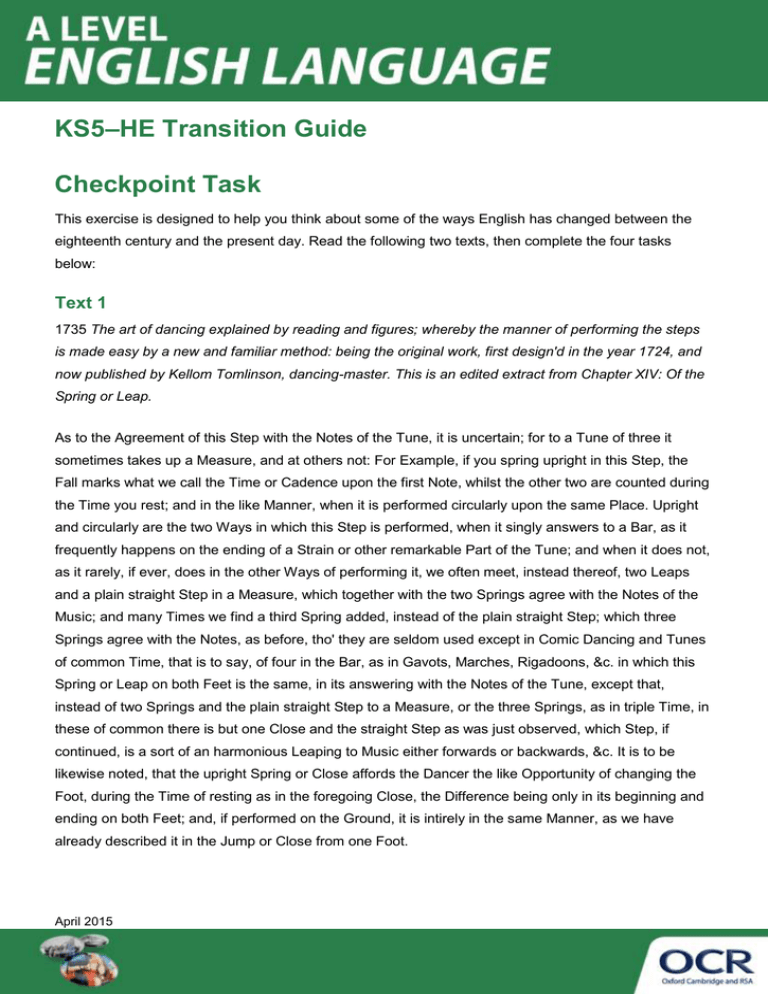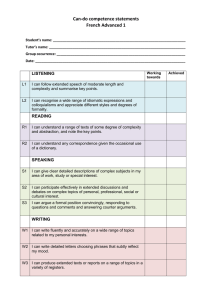KS5-HE transition guide - Checkpoint task - Activity (DOC, 473KB)
advertisement

KS5–HE Transition Guide Checkpoint Task This exercise is designed to help you think about some of the ways English has changed between the eighteenth century and the present day. Read the following two texts, then complete the four tasks below: Text 1 1735 The art of dancing explained by reading and figures; whereby the manner of performing the steps is made easy by a new and familiar method: being the original work, first design'd in the year 1724, and now published by Kellom Tomlinson, dancing-master. This is an edited extract from Chapter XIV: Of the Spring or Leap. As to the Agreement of this Step with the Notes of the Tune, it is uncertain; for to a Tune of three it sometimes takes up a Measure, and at others not: For Example, if you spring upright in this Step, the Fall marks what we call the Time or Cadence upon the first Note, whilst the other two are counted during the Time you rest; and in the like Manner, when it is performed circularly upon the same Place. Upright and circularly are the two Ways in which this Step is performed, when it singly answers to a Bar, as it frequently happens on the ending of a Strain or other remarkable Part of the Tune; and when it does not, as it rarely, if ever, does in the other Ways of performing it, we often meet, instead thereof, two Leaps and a plain straight Step in a Measure, which together with the two Springs agree with the Notes of the Music; and many Times we find a third Spring added, instead of the plain straight Step; which three Springs agree with the Notes, as before, tho' they are seldom used except in Comic Dancing and Tunes of common Time, that is to say, of four in the Bar, as in Gavots, Marches, Rigadoons, &c. in which this Spring or Leap on both Feet is the same, in its answering with the Notes of the Tune, except that, instead of two Springs and the plain straight Step to a Measure, or the three Springs, as in triple Time, in these of common there is but one Close and the straight Step as was just observed, which Step, if continued, is a sort of an harmonious Leaping to Music either forwards or backwards, &c. It is to be likewise noted, that the upright Spring or Close affords the Dancer the like Opportunity of changing the Foot, during the Time of resting as in the foregoing Close, the Difference being only in its beginning and ending on both Feet; and, if performed on the Ground, it is intirely in the same Manner, as we have already described it in the Jump or Close from one Foot. April 2015 Text 2 [2012 Anonymous How to Top Rock] How to top rock is the first breakdance tutorial of the beginners section. We’re going to start with the basics of breakdancing, first we’re going to start out with top rock. This might not seem too difficult when you see it, but remember you have to keep up with the rhythm. That’s where the difficulty comes in to play. Make sure you stand on your toes to be able to bounce and keep up with the beat. Get up on your tippy toes and move one leg to the other side. Right leg, over the left. Jump back in to the resting position, left leg over right, hop back into resting position. Keep repeating this, practice it. Make sure it’s with a rhythm, if it’s not, then it won’t look good at all. Don’t dance to the rhythm of your own drum, follow the beat. Of course it won’t be just that. It’ll look way more different, the beat determines how much you move. Just remember back and forth, then resting position. Rinse and repeat. Always try to find the rhythm to a baseline or snare line. Every song has a beat and you can top rock to it. You can even incorporate hopping into the top rocking. If you feel like you’ve gotten enough practice, then you can incorporate hands. Let your hands swing with your body a bit; don’t be afraid to loosen up. However don’t let them flail either. Practice in the mirror will show you if you’re swinging your arms to much. Just make sure to remember your following your feet. April 2015 Task 1 Describe some of the ways in which the eighteenth century text differs from the contemporary text in terms of orthography. In particular, pay attention to capitalization and to punctuation: Is the capitalization in the earlier text random, or is there a system to it? Do you think the punctuation in the later text conforms to standard English? What evidence do you have to support your answer? April 2015 Task 2 What grammatical differences are there between the two texts? Pay attention to the types of clauses used (eg declaratives vs. imperatives), and the complexity of the clauses (eg whether there is a lot of subordination). How do the grammatical choices relate to the varying level of formality associated with each text? April 2015 Task 3 Identify some idiomatic expressions used in Text 2. Do you find similar uses of idiomatic language in Text 1? April 2015 Task 4 Both of these texts are instructional texts – they are each giving advice on how to carry out a dance move. What features of the discourse mark these texts out as being instructional? Do the discourse properties of both texts appear to be the same, or are they different in some ways? April 2015


